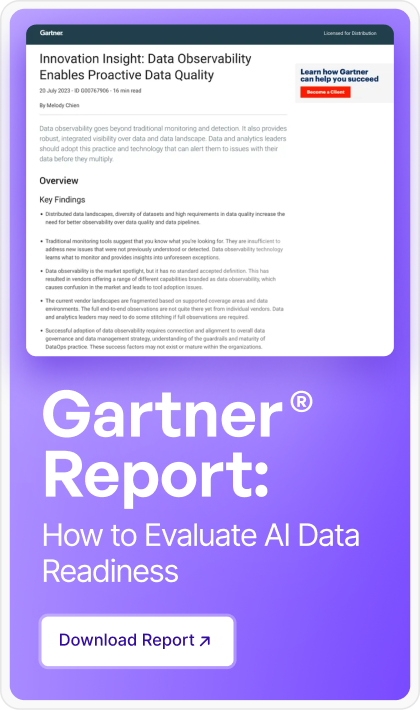Over the past few years, organizations have experienced a noticeable shift from the “application world” to the “data world”. What does this mean?
With the explosive tsunami of data in the past couple of decades, enterprises have realized that managing your data correctly is the key to business success.
As the modern data stack gets more and more complex by the day, the modern infrastructures and methodologies have moved from managing sprawling business processes to getting your data-driven landscapes right.
Data is king now! And think about it: your data pipelines are your business processes today.
Goal of highly regulated industries
All organizations - and especially highly-regulated enterprises - endeavour to build TRUST. Customer trust. Partner trust. Supply-chain trust. Stakeholder and shareholder trust. Service-level trust. Product delivery trust.
All this boils down to maintaining trust, reliability and accuracy of data, as well as maintaining the reliability and optimal efficiency of the infrastructure and pipelines that handle your key business data.
As the CEO of Acceldata, Rohit Choudhary, has mentioned in his 2024 predictions on VMBlog: “Data isn't just about having it; it's about handling it right.”
In the past decades, business processes and applications were an organization’s key business asset, and these needed to be accurate, optimally operational and without flaws- for enterprises to be fully compliant and functional.
But in this data age, to be compliant and optimal, effectively managing hitherto unimagined volumes of data - at rest, in motion and for consumption - has become the key to the success of any organization.
In our current world, data needs to be protected and reliable. The data pipelines and infrastructure that handle this key data need to be optimally functional and without breakdowns or slowdowns. Data (and everything that handles data!) needs to be treated like a valuable business asset and requires continuous observation.
Additional responsibility for highly-regulated industries in this “Data World”
To top this complexity of the “data explosion” and the shifting importance to everything related to data, in recent years, highly regulated industries, such as financial services, data providers, telecom, oil and gas, healthcare and life sciences have the additional responsibility of adherence to strict government and industry regulations and mandates. These highly regulated industries are subject to strict regulations and compliance requirements due to the critical nature of their operations and the potential impact on consumers and society.
Adherence to compliance requirements and policies in these highly-regulated enterprises is not only critical to maintaining public trust and protecting consumers, but also to avoiding severe penalties, legal actions and reputational damage.
2000’s: How did highly regulated industries remain compliant
In the 2000’s and 2010’s, the primary focus of highly regulated industries was on compliance efforts and maintaining operational efficiencies in business processes and applications - primarily residing in ERP.
In these past couple of decades, since their business processes and logic as well as data resided in ERP, organizations ensured compliance by investing in GRC (Governance, Risk, and Compliance) and application monitoring systems:
- GRC systems allowed these organizations to establish and enforce policies and procedures to comply with industry regulations and legal standards, monitor and mitigate risks, prevent fraud and demonstrate transparency and accountability.
- Application monitoring systems continuously tracked.
the performance, availability, and security of critical software applications, providing real-time insights and alerts to potential issues, which helped prevent service disruptions, breaches, and compliance violations.
By integrating GRC and application monitoring, these industries have maintained a proactive approach to risk management, regulatory compliance, and safeguarding sensitive data, ultimately ensuring they operate with the highest level of security, trust, and compliance.
NOW: Data Observability helps highly regulated enterprises remain compliant
As discussed, we are now living in a “data-dominated world”, where the organization’s success is dependent on reliable data as well as the operational and cost-effectiveness of their data landscape.
Meticulously and cautiously managing the reliability of an organization’s data early in the data landscape (so it causes little to no damage downstream), continuously maintaining operational efficiencies in the data infrastructure and pipelines and having complete visibility and control over the cost of the data landscape is the KEY to the success of these highly-regulated industries in today’s data-driven infrastructures and operations.
Just as industries used to invest in GRC as well as application monitoring systems in the 2000s and 2010s, similarly, in the 2020s, investing in Data Observability is the need of the hour for highly regulated industries today.
What is Data Observability?
Acceldata not only coined the term: “Data Observability” in 2018, but also made it a reality and easy for enterprises to operationalize at scale.
Acceldata’s definition of data observability is also completely in line with Gartner’s report which states:
Put simply - Data Observability provides robust, integrated visibility over data and data landscapes to alert data teams to data reliability, operational and cost issues therein, and enables them to take action and fix these issues before they multiply and prevent future occurrences.
The Acceldata data observability platform maximizes the quality and reliability of data, eliminates operational blindspots, ensures optimal performance of data infrastructure and reduces the spend for an organization’s data stack.
Unlike siloed solutions that address only single aspects of data reliability (e.g. data quality) or niche areas of the data landscape, the Acceldata Data Observability Platform synthesizes signals from multiple layers of the data stack and delivers comprehensive, actionable information with root-causes analysis and drilldowns at several levels, so data teams can move fast and intelligently.
With the Data Reliability and Operational & Spend Intelligence solutions, Acceldata is the only single-pane of glass that provides comprehensive insights into ALL FIVE dimensions of observability:
- The data itself
- Data pipelines
- Data infrastructure and compute
- Data users
- Data spend and allocations
Besides these comprehensive actionable insights, the Acceldata platform also goes a step further and helps enterprises achieve the ultimate end goal of not just resolving but preventing issues related to data quality, operational performance and cost in their data landscapes!
How highly-regulated industries benefit from Data Observability
.png)
Just as organizations governed by strict mandates focused on the operational efficiencies and correctness of their business processes and applications in the 2000’s and 2010’s, the shift to our current “Data is King” world automatically entails that these highly regulated industries should invest in Data Observability for the following reasons:
Reliable Data
Since having reliable and accurate data is the KEY to the success of organizations nowadays, investing in a Data Reliability solution - especially one that catches problems at the source or “left-hand side of your data landscape” - is required to ensure that only accurate and high-quality data flows downstream into your data supply chain.
Optimal Data Supply Chain
Continuously ensuring that your data landscape, data operations and data supply chain functions run smoothly and optimally is KEY to preventing outages and establishing the assurance that your business data is available for business decision-making, adhering to mandates and being constantly compliant.
Optimal Spend
Having reliable data and an optimally running data supply chain definitely makes business and adherence to mandates smooth and easy. Additionally, having a data observability solution that also provides deep insights into the cost implications of maintaining your data landscapes and ensuring a smooth data supply chain is the icing on the cake!
Prevent Cost Overruns with Accurate Allocations and Optimal Budgeting
Data teams need to ensure reliable data and optimal data operations, but DataOps, Finance and Executives need to ensure that costs are in control, especially in this economy. So, a data observability solution, which not only also helps organizations identify and optimize data spend, but also provides ML-driven recommendations to eliminate cost overruns, and helps organizations allocate resources accurately and budget and plan effectively, really provides a complete package for these industries!
Remediate and Prevent Data issues
Leveraging a data observability solution that continuously offers native automated actions to remediate issues and ML-driven configuration recommendations to prevent future occurrences significantly helps data teams free up time to focus on business priorities, rather than spending hours on troubleshooting.
Reliable and Accurate Data Ensures Compliance and Adherence
Nowadays, bad data is synonymous to non-compliance and resulting penalties, legal actions and reputational damage. In today’s data-dominated world, as all organizations increasingly rely on data-driven decision-making, reliable data and operational efficiencies ensure accurate business decision-making and meeting optimal SLAs, and also enable highly regulated industries to comply with mandates and regulations effectively.
Focus on your business! Let data observability scale for you!
In the 2000s and 2010s, many organizations started out with the approach of managing GRC and application monitoring by building in-house applications. The reasoning behind this was that they knew their business best and liked to keep these systems that helped them remain compliant in their processes and applications in-house, so that they had more control over them. Also, highly-regulated organizations were inherently sceptical of outside solutions managing their efforts to be compliant with mandates.
But over time, as their processes and applications multiplied with their expanding business, it was not possible to scale up their development efforts to match the exploding volume of business processes, application proliferation, and ever-increasing mandates and requirements. Keeping pace with the mandates and best practices in the industry and technology required too much in-house human resources (and costs + time!)
These efforts took away their focus from their core business, and they very soon realized that investing in GRC and application monitoring solutions is best, as they would be their continuous trusted partner in ensuring adherence to new mandates in requirements as well as technologies, new best practices that helped optimize their operations, etc.
Data Observability: One-Stop Solution
Similar to the approach taken in the past 2 decades, many organizations started out thinking that data observability, or at least parts of the functionality, maybe something that can be built in-house. But, similar to their learnings from thepast 2 decades in GRC and application observability, these highly regulated enterprises have realized that it is in their best interest, operationally and financially to focus their teams and efforts on their core business and invest in a dedicated data observability solution, which already has hundreds of thousands of development and building efforts behind it!
Also, a data observability solution, such as the Acceldata Data Observability Cloud (ADOC) platform, ensures that their customers are in compliance with the latest infrastructure, the latest best practices, and the latest data and primitives available for ensuring data quality, spending and operational efficiencies from multiple vendors, pipelines and cloud platforms - on a continuous basis.
Summary
Similar to how highly-regulated industries invested in GRC and application monitoring systems in the 2000s and 2010s, in today’s data age, these organizations find that investing in a Data Observability is the need of the hour to maintain the reliability of their business data, and to maintain operational and cost efficiencies of their data landscapes.
The key to success for these organizations is being able to provide accurate, reliable and high-quality data downstream for consumption for optimal decision-making, customer service and compliance with requirements and mandates.
Enterprises have realized that it is important to invest in a solution like Acceldata which can “hold your hand” and be your partner in your journey - whether you are on-prem or on the cloud, or “anywhere in between''! Acceldata is committed to helping you continuously ensure the reliability of your data, with the optimal operational and cost efficiencies, so that your data operations can scale easily with your organizational growth and you can focus on your core business.














.webp)
.webp)


